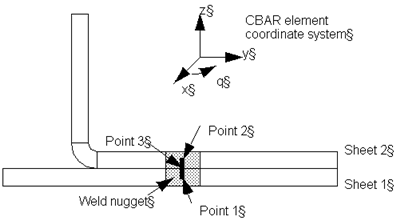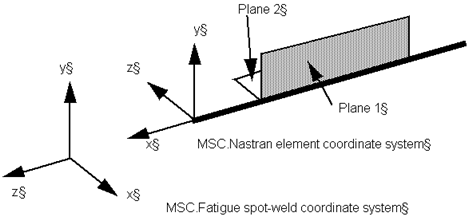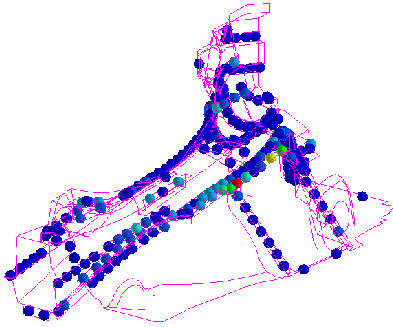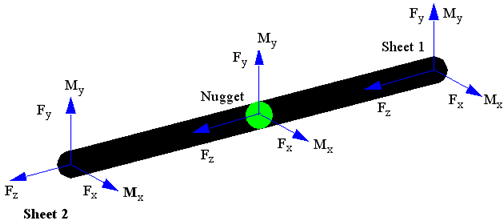XXXXXXXXXXXXXXXXXXXXXXXXXXXXXXXXXXXXXXXXXXXXXXXXXXXXXXXXXXXXXXXXXXXXXXXXXXXXXXXXXXXXXXXXXXXXXXXXXXXXXXXXXXXXXXXXXXXXXXXXXXXXXXXXXXXXXXXXXXXXXXXXXXXXXXXX''"> Geometry and FE Results
The geometry and FE results are contained in the file spot.op2. Copy this file over to a clean directory and open a new database called spotweld. Import both the model and the results in the typical way for MSC Nastran as illustrated in most of the previous exercises.
Because the CBAR are very small in comparison to the overall model dimensions, they have been plotted to the left as small spheres to visualize where on the model they are located. The spheres have been color coded according to element force magnitude for the first load case (horizontal force).
Because the spot welds are modeled as stiff CBAR elements, only a coarse mesh is required. The CBAR are used as force transducers to obtain forces and moments transmitted through the spot weld. MSC Nastran CBAR forces and moments are used to calculate structural stresses in the actual fatigue analysis.
The spot welds are placed between the sheets joining the mid-planes of the two sheets of shell elements, and perpendicular to both. The length of the spot weld and the sheet separation should therefore be half the sum of the sheet thicknesses. There is no need for any refinement of the mesh around the spot-welds. The only requirement for the shell elements used to model the sheets is that they transmit the correct loads to the bar elements. In fact, the best results are achieved when the dimensions of the shell elements are quite large - more than twice the diameter of the weld nuggets.

A typical spot-weld is illustrated above. The shaded part is the spot weld nugget. Again, the length of the CBAR element must be 0.5(s1+s2) where s1 and s2 are the thicknesses of sheets 1 and 2 respectively. Point 3 is on the axis of the weld nugget and at the interface of the 2 sheets, i.e., 0.5s1 from Point 1. All forces and moments are taken to be in the MSC Fatigue CBAR element coordinate system illustrated below. This is taken to be a Cartesian system with the Z axis going from Point 1 to Point 2.

The translator extracts forces and moments Fx,y,z and Mx,y,z in the MSC Fatigue coordinate system, and in the conventional right-handed sense, from the results in the database, for each of the three specified points. These forces and moments (except Mz) are used to calculate nominal stresses (structural stresses) on the inner surface of sheet 1 and sheet 2, and in the weld nugget at the interface of the two sheets, at intervals around the circumference of the spot weld (θ=0 degrees to 360 degrees by increments of 10 degrees). The forces and moments at points 1 and 2 are those applied by the spot welds on the sheets, and the forces and moments at point 3 will be those applied by the upper section (between point 3 and point 2) on the lower section (between point 1 and point 3).




